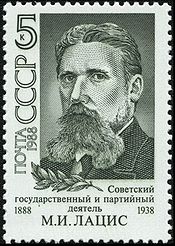- Martin Latsis
-
For the Latvian diplomat, see Mārtiņš Lācis.For the Greek tycoons, see Spiros Latsis and Yiannis Latsis.
 Postage stamp, USSR (1988)
Postage stamp, USSR (1988)
Martin Ivanovich Latsis (Russian: Мартын Иванович Лацис Latvian: Mārtiņš Lācis, born Jānis Sudrabs) (December 14, 1888 – February 11, 1938) was a Latvian-born Soviet politician, revolutionary and state security high officer. He was a member of the Bolshevik Party since 1905 (an "Old Bolshevik")[1], an active participant in the Russian Revolutions of 1905–1907 and 1917, a member of the Military Revolutionary Committee, a member of the Collegium of the All-Russia Cheka (1918–1921) and Chairman of the Cheka in Ukraine (1919), and a member of VTsIK. Between 1932 and 1937, Latsis was a director at the Plekhanov Russian Academy of Economics.
Latsis was the author of the book Dva goda borby na vnutrennom fronte ("Two Years of Struggle in the Internal Front", Moscow: Gos. izd-vo, 1920), in which he advocated unrestrained violence against class enemies. He boasted of the harsh repressive policies used by the Cheka.[2] In 1918, while a deputy chief of the Cheka in Ukraine, he established the principle that sentences were not to be determined by guilt or innocence—but by social class. He is quoted as explaining the Red Terror as follows:
We are engaged in exterminating the bourgeoisie as a class. You need not prove that this or that man acted against the interests of the Soviet power. The first thing you have to ask an arrested person is: To what class does he belong, where does he come from, what kind of education did he have, what is his occupation? These questions are to decide the fate of the accused. That is the quintessence of the Red Terror.[3]Latsis became a victim of the stalinist regime himself during the 1930s Great Purge, when he was arrested, accused of belonging to a "counter-revolutionary, nationalist organization", and shot in 1938.
In 1956, the post-Stalin government of Nikita Khrushchev politically rehabilitated him.[2]
See also
References
- ^ Adelman, Jonathan R. (editor); Terror and Communist Politics: The Role of the Secret Police in Communist States, Westview Press, 1984; ISBN 9780865312937; page 81
- ^ a b "Latsis Martin Ivanovich", a biography at www.hrono.ru (in Russian)
- ^ Tolczyk, Dariusz See no evil: Literary cover-ups and discoveries of the Soviet camp experience Yale University Press, 1999, p. 19. ISBN 978-0300066081
Literature
- Solzhenitsyn, Aleksandr; The Gulag Archipelago, Harper & Row, 660 pp., ISBN 0-06-080332-0.
- Gordievsky, Oleg; Andrew, Christopher, KGB: The Inside Story (1990), Hodder & Stoughton. ISBN 0-340-48561-2.
Categories:- 1888 births
- 1938 deaths
- Old Bolsheviks
- Latvian people
- Cheka
- Great Purge victims
Wikimedia Foundation. 2010.
